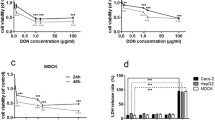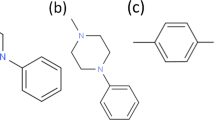Abstract
Purpose. The aim of the present study was to evaluate whether the transepithelial transport of the anticancer compound 4-toluenesulfonylureido-carnosine (Ts-carnosine) and the dipeptide moiety L-carnosine was due to a hPepT1 carrier-mediated flux.
Methods. Transport experiments were conducted using Caco-2 cell monolayers and either reversed-phase HPLC-UV or liquid scintillation counting methods for quantification. pKa, LogD, and LogP were determined using the Sirius GlpKa meter.
Results. L-carnosine was transported across the apical membrane with a Km,app of 2.48 ± 1.16 mM and a Vmax of 2.08 ± 0.34 nmol · cm−2 · min−1 and across the basolateral membrane with a Km,app of 7.21 ± 3.17 mM and a Vmax of 0.54 ± 0.10 nmol · cm−2 · min−1, and transepithelially with a Papp of 4.46 · 10−2 ± 6.4 · 10−6 cm · min−10. Ts-carnosine had an affinity (Ki) for hPepT1 of 2.33 ± 0.54 mM; however, the transepithelial transport was low as compared to that of L-carnosine.
Conclusions. L-carnosine was transported across both the apical and basolateral membrane of Caco-2 cell monolayers in a carrier-mediated manner however, the transepithelial transport followed apparent simple non-saturable kinetics. Ts-carnosine had an affinity for hPepT1 but a relatively low transepithelial transport. This indicates that the transepithelial transport of L-carnosine and Ts-carnosine is not hPepT1 carrier-mediated and that L-carnosine is not a suitable dipeptide moiety for hPepT1-mediated absorption of sulfonamide-type anticancer compounds.
Similar content being viewed by others
REFERENCES
C. T. Supuran, F. Briganti, S. Tilli, W. R. Chegwidden, and A. Scozzafava. Carbonic anhydrase inhibitors: sulfonamides as antitumor agents? Bioorg. Med. Chem. 9:703–714 (2001).
C. T. Supuran and A. Scozzafava. Carbonic anhydrase inhibitors: aromatic sulfonamides and disulfonamides act as efficient tumor growth inhibitors. J. Enzyme Inhib. 15:597–610 (2000).
A. Mastrolorenzo, A. Scozzafava, and C. T. Supuran. 4-Toluenesulfonylureido derivatives of amines, amino acid and dipeptides: a novel class of potential antitumor agents. Eur. J. Pharm Sci. 11:325–332 (2000).
B. Bretschneider, M. Brandsch, and R. Neubert. Intestinal transport of ?-lactam antibiotics: analysis of the affinity at the H+/peptide symporter (PEPT1), the uptake into caco-2 cell monolayers and the transepithelial flux. Pharm. Res. 16:55–61 (1999).
M. Hu, P. Subramanian, H. I. Mosberg, and G. L. Amidon. Use of the peptide carrier system to improve intestinal absorption of L-alfa-methyldopa: carrier kinetics, intestinal permeabilities, and in vitro hydrolyisis of dipeptidyl derivatives of L-alfa-methyldopa. Pharm.Res 6:66–70 (1989).
K. Inui, T. Okano, H. Maegawa, M. Kato, M. Takano, and R. Hori. H+ coupled active transport of bestatin via the dipeptide transport system in rabbit intestinal brush border membranes: difference of transport characteristics between cefixime and cephradine. J. Pharmacol. Exp. Ther. 247:235–241 (1988).
Ganapathy V. and F. H. Leibach. Is intestinal peptide transport energized by a proton gradient? Am. J. Physiol. 249:G153–G160 (1985).
D. E. Gonzalez, K. M. Covitz, W. Sadee, and R. J. Mrsny. An oligopeptide transporter is expressed at high levels in the pancreatic carcinoma cell lines AsPc-1 and Capan-2. Cancer Res. 58:519–525 (1998).
R. J. Mrsny. Oligopeptide transporters as putative therapeutic targets for cancer cells. Pharm. Res. 15:816–818 (1998).
T. Nakanishi, I. Tamai, Y. Sai, T. Sasaki, and A. Tsuji. Carriermediated transport of oligopeptides in the human fibrosarcoma cell line HT1080. Cancer Res. 57:4118–4122 (1997).
T. Nakanishi, I. Tamai, A. Takaki, and A. Tsuji. Cancer celltargeted drug delivery utilizing oligopeptide transport activity. Int. J. Cancer 88:274–280 (2000).
C. A. Boyd and M. R. Ward. A micro-electrode study of oligopeptide absorption by the small intestinal epithelium of Necturus maculosus. J. Physiol. Lond. 324:411–428 (1982).
R. P. Ferraris, J. Diamond, and W. W. Kwan. Dietary regulation of intestinal transport of the dipeptide carnosine. Am. J. Physiol 255:G143–G150 (1988).
V. Ganapathy and F. H. Leibach. Role of pH gradient and membrane potential in dipeptide transport in intestinal and renal brush-border membrane vesicles from the rabbit: Studies with L-carnosine and glycyl-L-proline. J. Biol. Chem. 258:14189–14192 (1983).
V. M. Rajendran, A. Berteloot, Y. Ishikawa, A. H. Khan, and K. Ramaswamy. Transport of carnosine by mouse intestinal brushborder membrane vesicles. Biochim. Biophys. Acta 778:443–448 (1984).
P. F. Bai, P. Subramanian, H. I. Mosberg, and G. L. Amidon. Structural requirements for the intestinal mucosal-cell peptide transporter: the need for N-terminal alpha-amino group. Pharm. Res. 8:593–599 (1991).
M. Hu and G. L. Amidon. Passive and carrier-mediated intestinal absorption components of captopril. J. Pharm. Sci. 77:1007–1011 (1988).
D. Meredith, C. S. Temple, N. Guha, C. J. Sword, C. A. Boyd, I. D. Collier, K. M. Morgan, and P. D. Bailey. Modified amino acids and peptides as substrates for the intestinal peptide transporter PepT1. Eur. J. Biochem. 267:3723–3728 (2000).
D. I. Friedman and G. L. Amidon. Passive and carrier-mediated intestinal absorption components of two angiotensin converting enzyme (ACE) Inhibitor Prodrugs in Rats: Enalapril and Fosinopril. Pharm. Res. 6:1043–1047 (1989).
T. Fujita, Y. Morishita, H. Ito, D. Kuribayashi, A. Yamamoto, and S. Muranishi. Enhancement of the small intestinal uptake of phenylalanyl-glycine via a H+/oligopeptide transport system by chemical modification with fatty acids. Life Sciences 61:2455–2465 (1997).
C. U. Nielsen, J. Amstrup, B. Steffansen, S. Frokjaer, and B. Brodin. Epidermal growth factor (EGF) inhibits glycylsarcosine (Gly-Sar) transport and hPepT1 expression in a human intestinal cell line. Am. J. Physiol. Gastrointest. Liver Physiol. 281:G191–G199 (2001).
P. L. Smith. Methods for evaluating Intestinal permeability and metabolim in vitro. In R. T. Borchardt and et al. (eds), Models for Assessing Drug Absorption and Metabolism, Plenum Press, New York, 1996, pp. 13–34.
C. U. Nielsen, R. Andersen, B. Brodin, S. Frokjaer, and B. Steffansen. Model prodrugs for the intestinal oligopeptide transporter: Model drug release in aqueous solution and in various biologic media. J. Controlled Release 73:21–30 (2001).
Cheng. Y.C. and W. H. Prusoff. Relationship between the inhibition constant (Ki) and the concentration of inhibitor which causes 50 per cent inhibition (I50) of an enzymatic reaction. Biochem Pharmacol 22:3099–3108 (1973).
M. Irie, T. Terada, K. Sawada, H. Saito, and K. I. Inui. Recognition and transport characteristics of nonpeptidic compounds by basolateral peptide transporter in caco-2 cells. J. Pharmacol. Exp. Ther. 298:711–717 (2001).
H. Saito and K. Inui. Dipeptide transporters in apical and basolateral membranes of the human intestinal cell line caco-2. Am. J. Physiol. 265:G289–G294 (1993).
T. Terada, K. Sawada, H. Saito, Y. Hashimoto, and K. Inui. Functional characteristics of basolateral peptide transporter in the human intestinal cell line Caco-2. Am. J. Physiol 276:G1435–G1441 (1999).
J. D. Larsen and H. Bundgaard. Prodrug forms for the sulfonamide group. 1. Evaluation of N-acyl derivatives, N-sulfonamidines, N-sulfonylsulfilimines and sulfonureas as possible prodrug derivatives. Int. J. Pharm 37:87–95 (1987).
T. Terada, K. Sawada, M. Irie, H. Saito, Y. Hashimoto, and K. Inui. Structural requirements for determining the substrate affinity of peptide transporters PEPT1 and PEPT2. Pflugers Arch. 440:679–684 (2000).
M. Sugawara, W. Huang, Y. J. Fei, F. H. Leibach, V. Ganapathy, and M. E. Ganapathy. Transport of valganciclovir, a ganciclovir prodrug, via peptide transporters PEPT1 and PEPT2. J. Pharm. Sci. 89:781–789 (2000).
E. P. Eddy, C. Wood, J. Miller, G. Wilson, and I. J. Hidalgo. A comparison of the affinities of dipeptides and antibiotics for the di-/tripeptide transporter in Caco-2 cells. Int. J. Pharm. 115:79–86 (1995).
I. Knutter, S. Theis, B. Hartrodt, I. Born, M. Brandsch, H. Daniel, and K. Neubert. A Novel Inhibitor of the Mammalian Peptide Transporter PEPT1. Biochemistry 40:4454–4458 (2001).
H. Abe, M. Satoh, S. Miyauchi, S. Shuto, A. Matsuda, and N. Kamo. Conjugation of dipeptide to fluorescent dyes enhances its affinity for a dipeptide transporter (PEPT1) in human intestinal caco-2 cells. Bioconjugate Chem. 10:24–31 (1999).
P. Y. Yeh, N. Hagen, M. Guldbrandt, C. Nielsen, H. Ellens, and P. L. Smith. Functional characteristics of the intestinal efflux system in in vitro intestinal models. Proceed. Int'l Symp Control. Rel. Bioact. Mater. 25:6–7 (1998).
F. Ushigome, H. Takanaga, H. Matsuo, S. Yanai, K. Tsukimori, H. Nakano, T. Uchiumi, T. Nakamura, M. Kuwano, H. Ohtani, and Y. Sawada. Human placental transport of vinblastine, vincristine, digoxin and progesterone: contribution of P-glycoprotein. Eur. J. Pharmacol. 408:1–10 (2000).
F. J. Sharom and G. DiDiodato. X. Yu, and K. J. D. Ashbourne. Interaction of the P-glycoprotein Multidrug Transporter with Peptides and Ionophores. J. Biol. Chem. 270:10334–10341 (1995).
M. C. de Jong, J. W. Slootstra, G. L. Scheffer, A. B. Schroeijers, W. C. Puijk, R. Dinkelberg, M. Kool, H. J. Broxterman, R. H. Meloen, and R. J. Scheper. Peptide transport by the multidrug resisance protein MRP1. Cancer Res. 61:2552–2557 (2001).
Author information
Authors and Affiliations
Corresponding author
Rights and permissions
About this article
Cite this article
Nielsen, C.U., Supuran, C.T., Scozzafava, A. et al. Transport Characteristics of L-Carnosine and the Anticancer Derivative 4-Toluenesulfonylureido-Carnosine in a Human Epithelial Cell Line. Pharm Res 19, 1337–1344 (2002). https://doi.org/10.1023/A:1020306926419
Issue Date:
DOI: https://doi.org/10.1023/A:1020306926419




